Environment & Natural Resources Class 12 Political Science
Introduction
Environmental problems like land damage, too much fishing, and dirty water are closely connected to global politics. They raise important questions about who is responsible and who has power. Solving these problems requires countries to work together.
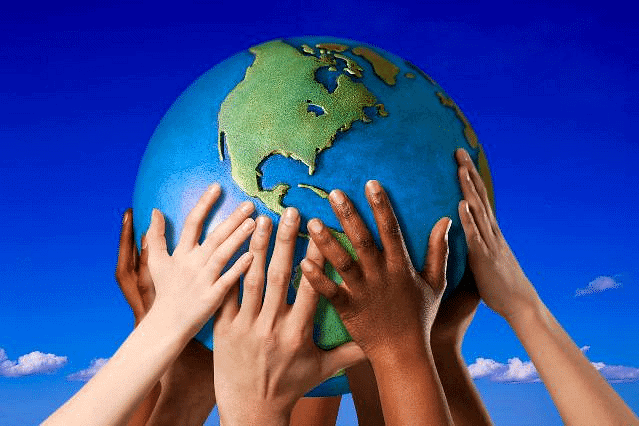
Environmental Concerns in Global Politics
- Key Issues: Environmental concerns became a central part of global politics from the 1960s onwards. The 1972 Limits to Growth report raised early alarms. The 1992 UN Conference in Rio de Janeiro (Earth Summit) marked a major milestone. Organisations like UNEP began global conferences and studies to find coordinated solutions.
- Environmental Impact: Fertile land is shrinking; grasslands and fisheries are overused. Water bodies are polluted, reducing food production. Forests are being cut, causing climate change and biodiversity loss. Ozone layer depletion harms ecosystems and human health. Coastal pollution from human activity threatens marine life.
- Political Dimensions: No single country can solve these problems alone. Key questions arise: Who causes the damage? Who suffers most? Who should fix it? These are issues of power, justice, and responsibility, making the environment a deeply political issue.
- Global Divide: At the Rio Summit, developed countries (Global North) focused on global warming and ozone depletion. Developing countries (Global South) stressed the link between economic development and environmental care. This difference shaped global environmental debates.
- Agenda 21 & Sustainable Development: The Rio Summit introduced Agenda 21, a plan to balance growth with environmental responsibility, known as sustainable development. But how to achieve this balance remains debated. Critics argue that Agenda 21 leaned too much towards economic growth, not enough towards conservation.
The Protection of Global Commons
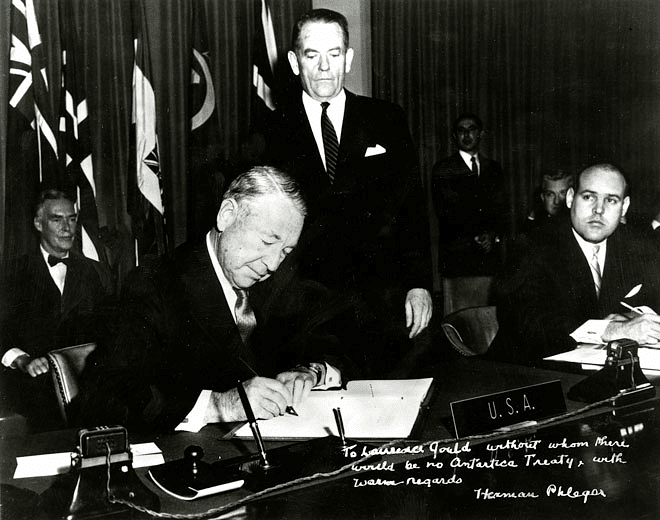 Signing of The Antarctic Treaty
Signing of The Antarctic Treaty
- Commons are resources shared by a community, not owned by anyone specifically, such as a common room, community centre, park, or river.
- Global commons are regions outside any single state's sovereignty, requiring international governance. Examples include: Earth's atmosphere, Antarctica, the Ocean floor and Outer space
- Cooperation over global commons is challenging due to Difficulties in achieving consensus on environmental agendas and Vague scientific evidence and time frames.
- Significant agreements include:
1959 Antarctic Treaty
1987 Montreal Protocol
1991 Antarctic Environmental Protocol - The ozone hole discovery in the mid-1980s highlighted both opportunities and challenges in addressing global environmental issues.
- Outer space management is affected by North-South inequalities, with disparities in technology and industrial development.
- The benefits of exploitative activities in global commons are uneven, impacting present and future generations differently.
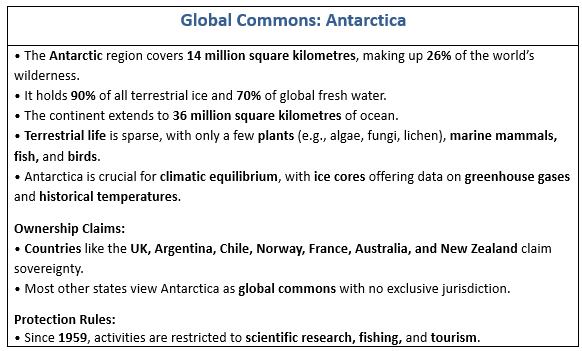 The Protection of Global Commons: Antarctica
The Protection of Global Commons: Antarctica
Common but Differentiated Responsibilities
North-South Approach Differences:
- The Northern countries want everyone to be equally responsible for ecological conservation.
- The developing nations of the South hold the view that the industrial development initiatives carried out by the developed nations are to blame for the ecological degradation.
- Introduced at the 1992 Earth Summit (Rio Declaration), this principle says all countries should work together to protect the Earth.
- However, it also recognises that developed countries caused more damage in the past and have better technology, so they should take greater responsibility.
- At the same time, it highlights that for developing countries, economic and social growth must come first.
United Nations Framework Convention on Climate Change (UNFCCC):
- UNFCCC emphasises action based on equity and common but differentiated responsibilities.
- Recognises that developed countries are historically responsible for the majority of greenhouse gas emissions, while per capita emissions in developing countries are lower.
Kyoto Protocol:
- Kyoto Protocol was Agreed upon in 1997 in Kyoto, Japan.
- Sets targets for industrialised countries to reduce greenhouse gas emissions.
- Exempts developing countries like China and India from emission reduction requirements.
- Focuses on gases like Carbon Dioxide, Methane, and Hydrofluorocarbons, which contribute to global warming and potentially catastrophic consequences.
Commons Property Resources
- Common property means resources shared by a community, where everyone has both the right to use them and the duty to take care of them. In many Indian villages, these rights and duties have developed over time through mutual understanding.
- However, things like privatisation, more farming, a growing population, and harm to the environment have reduced the size and quality of these resources, especially affecting the poor.
- A good example is the management of sacred groves on government forest land in South India, which are traditionally cared for by local communities.
- This issue is important worldwide, as the loss of common property resources due to privatisation and environmental damage often hits poorer communities the hardest.
India’s Stand on Environmental Issues

- India signed and ratified the 1997 Kyoto Protocol in August 2002.
- Developing countries like India and China were exempt from the Kyoto Protocol requirements due to their relatively small historical contributions to greenhouse gas emissions.
- Critics argue that developing countries, including India and China, will soon become significant contributors to greenhouse gas emissions.
- At the G-8 meeting in June 2005, India highlighted that per capita emissions in developing countries are much lower than those in developed countries.
- India maintains that developed countries should bear the primary responsibility for reducing emissions due to their historical contributions.
- India’s international negotiating stance is based on the principle of historical responsibility, as outlined in the UNFCCC, which emphasises prioritising economic and social development for developing countries.
- India is concerned that new binding commitments on rapidly industrialising countries might undermine the spirit of the UNFCCC.
- Despite rising per capita emissions, India’s emissions are predicted to remain below the global average.
- The Indian government is engaged in global environmental efforts, including the National Auto-fuel Policy, Energy Conservation Act, and Electricity Act, which promote cleaner energy and improved energy efficiency.
- India is also advancing projects such as the National Mission on Biodiesel and has one of the largest renewable energy programs globally.
- In 2016, India ratified the Paris Climate Agreement.
- A review in 1997 highlighted the lack of progress in transferring financial resources and technology to developing countries.
- India believes developed countries need to provide financial support and clean technologies to help developing nations meet their commitments under the UNFCCC.
- India advocates for a unified stance among SAARC countries on global environmental issues to strengthen the region’s influence.
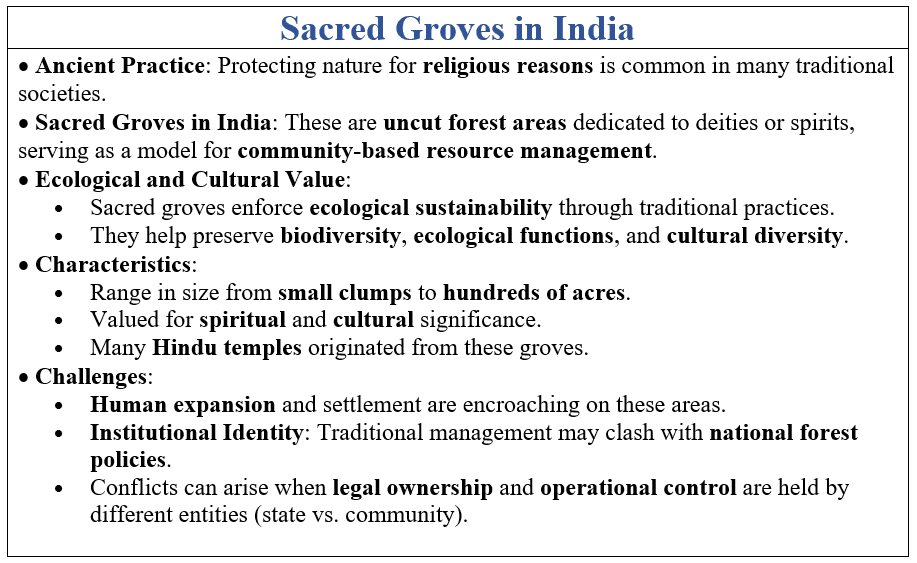 Sacred Groves in India
Sacred Groves in India
Environmental Movements: One or Many?
Volunteer-Led Movements as Responses to Environmental Degradation:
- Many impactful responses to environmental degradation come from environmentally conscious volunteers rather than governments.
- These movements operate at both international and local levels and are among the most vibrant and powerful social movements globally.
Purpose and Impact:
- Environmental movements introduce new ideas and long-term visions for both individual and collective actions regarding the environment.
Examples of Environmental Movements:
- Forest Movements: These focus on tackling deforestation in places like Mexico, Chile, Brazil, Malaysia, Indonesia, continental Africa, and India. Despite many years of activism, the destruction of the world's last great forests has actually increased recently. A key difference between forest movements in the South and those in the North is that Southern forests still have people living in them, while Northern forests are often seen as empty. This distinction is vital for understanding the social and environmental issues involved.
- Minerals Industry: This sector is one of the most significant industries globally. Many economies in the South are being reopened to multinational corporations (MNCs) due to global economic liberalisation. The minerals industry faces criticism for issues such as extraction, pollution, deforestation, and the displacement of communities.
Anti-Dam Movements: These movements oppose the building of large dams and support sustainable management of rivers. Notable examples include:
- The Franklin River campaign in Australia, which combined wilderness protection with anti-dam efforts.
- The Narmada Bachao Andolan in India, recognised for its commitment to non-violence as a shared principle among anti-dam movements.
Resource Geopolitics
- Fundamental Questions of Resource Geopolitics: This area looks at who gets what, when, where, and how resources are managed and controlled.
- Historical Context:
- European Expansion: Driven by the need for resources, this period led to the growth of power and competition between nations.
- Western Geopolitical Focus: Historically, this has centred on trade, warfare, and overseas resources, particularly maritime routes. A key issue has been the Western control of oil in the Gulf and strategic minerals in Southern and Central Africa.
- World Wars: It was vital to ensure a constant supply of key resources, especially oil.
- Cold War: During this time, developed nations used various strategies to secure a reliable flow of resources. These included deploying military forces near resource extraction sites, stockpiling essential materials, backing friendly governments in resource-rich countries, and supporting multinational corporations with favourable international agreements.
- Post-Cold War: Following the Cold War and the collapse of the Soviet Union, concerns about supply security continued to impact governmental and business decisions regarding various minerals, particularly radioactive materials.
- Oil:
- Oil remains the most crucial resource in global strategy, affecting the world economy and sparking political conflicts and wars, especially in West Asia and Central Asia.
- The Gulf region is vital, accounting for around 30% of global oil production and 64% of known reserves.
- Saudi Arabia and Iraq play significant roles, with Iraq potentially having larger reserves.
- Water: This resource is becoming increasingly important due to regional differences and scarcity. Conflicts may arise over shared water resources, including:
- Disagreements between upstream and downstream countries regarding pollution, irrigation, and dam building.
- Notable conflicts include those involving Israel, Syria, and Jordan over the Jordan and Yarmuk Rivers, and between Turkey, Syria, and Iraq over the Euphrates River.
- The 1992 Earth Summit highlighted environmental issues, bringing them to the forefront of global politics.
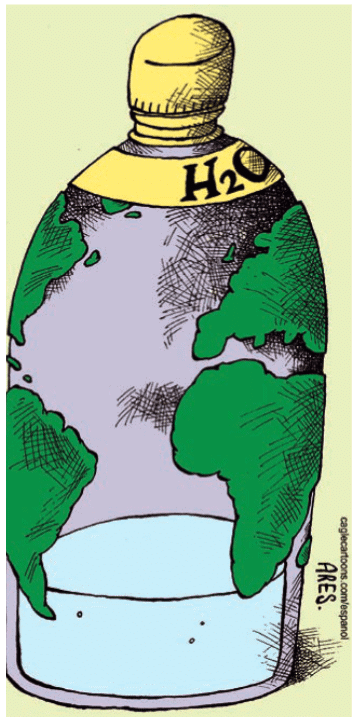
The Indigenous People and their Rights
Indigenous populations are descendants of people who lived in a territory before the arrival of different cultural or ethnic groups, as defined by the UN.
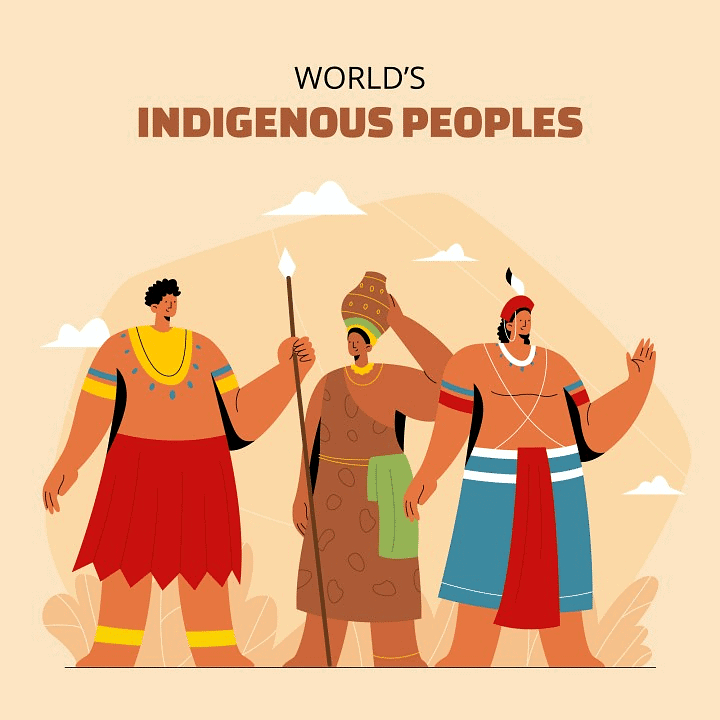
- Lifestyle: Indigenous peoples often live in alignment with their social, economic, and cultural customs rather than with national institutions.
- Global Presence: Approximately 300 million indigenous people are spread across regions such as India, the Philippines, Chile, Bangladesh, North America, Panama, and the Soviet North. They advocate for their struggles, rights, and equal status within the global community.
- Historical Occupation: Indigenous peoples have historically occupied areas in Central and South America, Africa, India, and Southeast Asia. In Oceania (including Australia and New Zealand), Polynesian, Melanesian, and Micronesian peoples have inhabited these regions for thousands of years.
- Challenges: Loss of land and economic resources threaten their survival and political autonomy. In India, Scheduled Tribes are considered indigenous and make up nearly 8% of the population. They depend on land cultivation and have faced displacement due to colonial rule and development projects.
- Development and Rights: Despite constitutional protections, indigenous people in India have faced limited benefits from development and significant displacement. Indigenous rights have been historically neglected in both domestic and international politics.
- International Advocacy: In the 1970s, international contacts among indigenous leaders led to the formation of the World Council of Indigenous Peoples in 1975, the first of 11 indigenous NGOs with UN consultative status. Movements against globalisation often highlight the rights of indigenous peoples.
Conclusion
Addressing environmental issues requires a global approach that considers resource management, indigenous rights, and historical responsibilities. Effective solutions depend on international collaboration to ensure a sustainable and just future.
|
34 videos|308 docs|51 tests
|
FAQs on Environment & Natural Resources Class 12 Political Science
| 1. What are some of the key environmental concerns in global politics? |  |
| 2. What is the concept of Common but Differentiated Responsibilities in relation to environmental issues? |  |
| 3. How does resource geopolitics impact environmental issues on a global scale? |  |
| 4. How does India approach environmental issues on the global stage? |  |
| 5. What role do indigenous peoples play in environmental protection and resource management? |  |






















